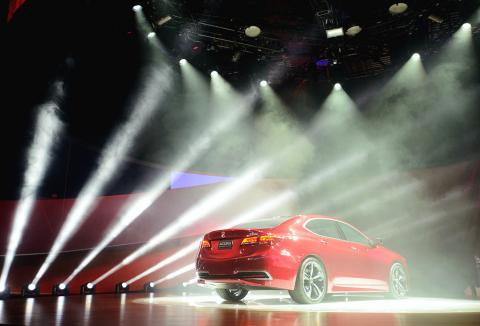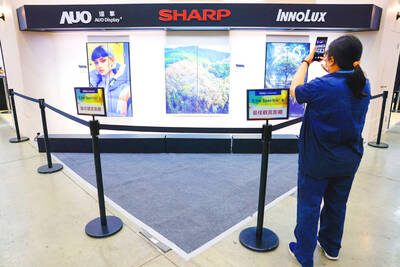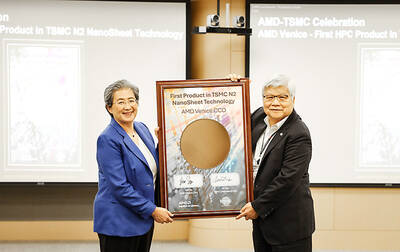With cars that park themselves, radar-guided safety sensors and infotainment systems with Web access, automakers are competing for customers who now expect constant innovation.
The speed at which the new features are migrating from premium models downward and spreading among brands is accelerating as automakers jostle for attention in an increasingly crowded market.
“The hottest new technology in cars today is voice-to-text functionality that reads a driver’s e-mails or texts as they come in and allows the driver to dictate a response without looking away from the road,” Kelley Blue Book senior analyst Karl Brauer said.

Photo: Bloomberg
Automakers have aligned themselves with tech giants to lure customers with increasingly complex — but hopefully still intuitive — systems to transform their consoles into souped-up smartphones.
Navigation has been upgraded to integrate online consumer reviews from Web sites and guide motorists to roadside businesses.
Touch screens reminiscent of Apple Inc’s iPad have been added to consoles outfitted with apps like Pandora music streaming.
Then there are the proprietary apps aimed at fixing life’s little problems.
Touch a button on a phone and a lost car will pop up on a map. Still cannot find it in the parking lot? Tap again and the phone will honk the car’s horn. Locked the keys inside? Another button opens the door.
If a parent is worried that their teenager is driving too fast or hanging out with the wrong crowd, there is an app that will send them a text message if the driver surpass a chosen speed or leave a designated area.
The real challenge for automakers is to make sure all of this technology does not become a dangerous distraction, said Art St Cyr, head of product planning at American Honda Motor Co.
Keeping it out of the car simply is not possible, people are too attached to their smartphones and “don’t want to be disconnected,” he said.
“The key is to reduce the cognitive load,” St Cyr told reporters on the sidelines of the North American International Auto Show in Detroit, Michigan.
Voice activation certainly helps, but automakers have also invested in developing safety systems that can compensate for distracted or sleepy drivers.
Initially available only in luxury cars and then premium models, complex collision-avoidance technology is being introduced to the mass market.
Chrysler Group LLC is decking out a new mid-sized 200 sedan unveiled in Detroit on Monday with an entry price of just US$21,700 with a full spectrum of safety features previously only available in pricier models.
Video cameras mounted onto the windshield detect lines in the road to warn drivers if they are straying out of a lane and electrical steering wheels will even kick the car back into position.
Radars mounted under the grill can see through fog to measure the distance to the nearest vehicle, register a change in speed and slow down or stop the car if a driver does not notice looming brake lights.
Also, a blind spot monitor will sound an alert if a driver misses a blinking light in the side view mirror and flips the turn signal.
Rear view cameras are becoming standard features even on entry-level models like Honda’s new compact Fit, while Kia Motors Corp is stepping up the game by adding front and side views to the K900 which was unveiled in Detroit.
Plenty of premium models are helping drivers with pesky parking problems by measuring distances and controlling the steering wheel for the perfect parallel — or even perpendicular — parking job.
BMW AG takes it a step further in its new electric i3 model, which hits showrooms in a few months. Not only does it help to search for parking spots big enough to squeeze into, it will then completely take over the job by controlling the steering, braking and acceleration.
Automakers are also competing with simpler features like a vacuum cleaner in Honda’s top-selling Odyssey minivan, a sensor that will pop the trunk of a Mercedes, Ford or Cadillac when your hands are full, and “EZ-lift” tailgates on the new GMC pickup.
However, the biggest innovations are under the hood, said Bob Carter, head of automotive operations at Toyota Motor Sales USA.
Complex hybrid engines have become commonplace and people are even getting used to seeing purely electric cars like Nissan Motor Co Ltd’s Leaf on the road.
The holy grail of “green” cars — hydrogen fuel-cell engines that emit nothing but water vapor — is already on the road in test markets and will be hitting Toyota showrooms next year. Rivals Ford Motro Co, Honda, BMW, Daimler AG and the Renault-Nissan Alliance will not be far behind.

TAKING STOCK: A Taiwanese cookware firm in Vietnam urged customers to assess inventory or place orders early so shipments can reach the US while tariffs are paused Taiwanese businesses in Vietnam are exploring alternatives after the White House imposed a 46 percent import duty on Vietnamese goods, following US President Donald Trump’s announcement of “reciprocal” tariffs on the US’ trading partners. Lo Shih-liang (羅世良), chairman of Brico Industry Co (裕茂工業), a Taiwanese company that manufactures cast iron cookware and stove components in Vietnam, said that more than 40 percent of his business was tied to the US market, describing the constant US policy shifts as an emotional roller coaster. “I work during the day and stay up all night watching the news. I’ve been following US news until 3am

UNCERTAINTY: Innolux activated a stringent supply chain management mechanism, as it did during the COVID-19 pandemic, to ensure optimal inventory levels for customers Flat-panel display makers AUO Corp (友達) and Innolux Corp (群創) yesterday said that about 12 to 20 percent of their display business is at risk of potential US tariffs and that they would relocate production or shipment destinations to mitigate the levies’ effects. US tariffs would have a direct impact of US$200 million on AUO’s revenue, company chairman Paul Peng (彭雙浪) told reporters on the sidelines of the Touch Taiwan trade show in Taipei yesterday. That would make up about 12 percent of the company’s overall revenue. To cope with the tariff uncertainty, AUO plans to allocate its production to manufacturing facilities in

Six years ago, LVMH’s billionaire CEO Bernard Arnault and US President Donald Trump cut the blue ribbon on a factory in rural Texas that would make designer handbags for Louis Vuitton, one of the world’s best-known luxury brands. However, since the high-profile opening, the factory has faced a host of problems limiting production, 11 former Louis Vuitton employees said. The site has consistently ranked among the worst-performing for Louis Vuitton globally, “significantly” underperforming other facilities, said three former Louis Vuitton workers and a senior industry source, who cited internal rankings shared with staff. The plant’s problems — which have not

COLLABORATION: Given Taiwan’s key position in global supply chains, the US firm is discussing strategies with local partners and clients to deal with global uncertainties Advanced Micro Devices Inc (AMD) yesterday said it is meeting with local ecosystem partners, including Taiwan Semiconductor Manufacturing Co (TSMC, 台積電), to discuss strategies, including long-term manufacturing, to navigate uncertainties such as US tariffs, as Taiwan occupies an important position in global supply chains. AMD chief executive officer Lisa Su (蘇姿丰) told reporters that Taiwan is an important part of the chip designer’s ecosystem and she is discussing with partners and customers in Taiwan to forge strong collaborations on different areas during this critical period. AMD has just become the first artificial-intelligence (AI) server chip customer of TSMC to utilize its advanced